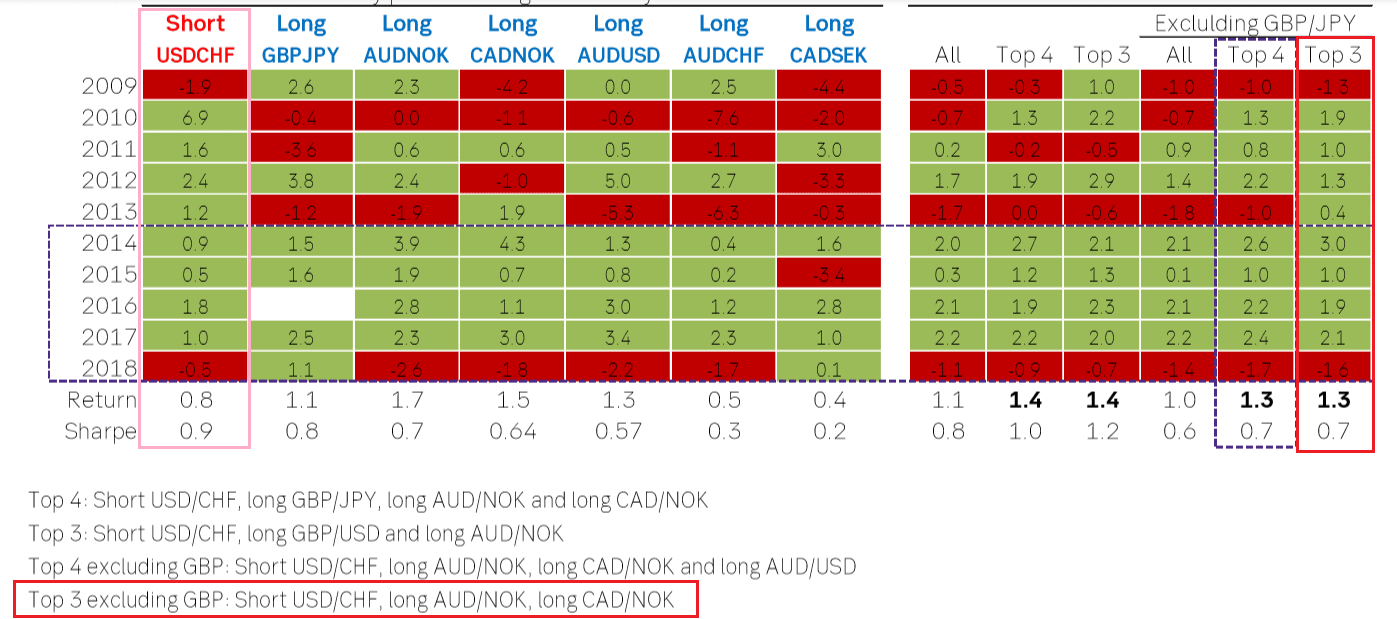June Seasonality Suggests Australian Dollar, Swiss Franc and Canadian Dollar are the Currencies to Own

Image © Adobe Images
- AUD, CAD, CHF gain whilst USD and NOK lose
- Yet June seasonality is not as clear cut as other months
The Australian Dollars, Swiss Francs, and Canadian Dollars could rise in June while the U.S. Dollars and Norwegian Krone could fall, according to research on seasonal currency trends from Scandinavian lender SEB.
“For June we recommend buying a seasonal basket which is long 50% AUD, 25% CHF, 25% CAD and short 50% NOK and 50% USD,” says SEB quantitative strategist Karl Steiner.
The call is based on a trading model developed by SEB that seeks to profit from seasonality in currencies
Pairs in SEB’s favoured FX basket are USD/CHF (short), AUD/USD (long), AUD/NOK (long) and CAD/NOK (long).
Over the past five years, SEB’s June FX basket made money 80% of the time - that is on four out of the last five Junes - with an average return of 1.3% during the month.
Results for the basket are shown bordered in black dotted line on the table below.
The Sharpe ratio for the SEB’s basket is 0.7. It provides a gauge for comparing the performance of different strategies.
The Sharpe ratio works by comparing the returns made to a risk-free investment such as a government bond.
It also factors in the variation in returns so as to take into account any skewing of the average by outlying or ‘freak’ results. It does this by including a calculation of the standard deviation of the strategy's profits.
A Sharpe ratio of 1.0 is normally considered acceptable by financial industry professionals. 2.0 is considered good.
This would seem to indicate that SEB’s June basket has performed slightly below that which would be normally considered adequate over the last 5 years.
This is not that surprising since 5 years is probably not long enough to gauge how well a strategy works. It only gives a sample of 5 trades, and the chances of the results (4 or more wins) being purely a chance occurrence are relatively high at 18.75%.
Over the 10 year period, the strategy was successful on 7 years, but even this could have been purely by chance. There is a 17.1% probability the results could have been a fluke.
Find a strategy with a success rate of 8 or more wins out of 10, however, and the probability of the results being a chance occurrence falls dramatically to just 5.5% which is very close to the generally accepted confidence level of less than 5.0% used for deciding if results have significance within the scientific community.
Looking at the results above, only one of the baskets (Top 3 excluding GBP) and selling USD/CHF have been successful in 8 out of the last 10 Junes. We have highlighted these in a red and pink box. These are more likely to prove successful given the lower probability they represent a fluke.
SEB’s basket strategy involves trading the pairs with a stop-loss to limit damage in the event the strategy fails. A stop-loss closes the trade if it goes the wrong way.
“To have an easy rule of thumb when tracking the performance of our portfolio we will apply a stop loss strategy where we exit a currency pair if it loses 75% of the average 5 year gain.”
Why June?
The fact that both safe-haven currencies like the Swiss Franc and higher risk currencies like the Aussie rise in June seems to imply no clear fundamental driver for the effect.
“It is difficult to draw inferences from the June seasonality in terms of the usual market environment. A strong CHF and weak Nordics (mainly NOK) indicates a risk-off sentiment but strong AUD and CAD combined with weak USD are somewhat of a contradiction to that,” says Steiner.
Yet at the same time the VIX which measures volatility has risen in 4 of the last 5 years revealing “at least increased concern among investors”.
Nordic equity markets have a tendency to fall in June as does oil, but this provides little clarity on underlying drivers.
“Nordic equity markets seem to perform poor in June (falling in four out of the past five years) which may partly explain the weak Nordic pattern. Oil is also showing a slight tendency to head lower which adds to the motif of weak NOK but not to why CAD tends to be stronger. Overall, the indications from common drivers are somewhat inconclusive,” says the SEB analyst.
Time to move your money? Get 3-5% more currency than your bank would offer by using the services of foreign exchange specialists at RationalFX. A specialist broker can deliver you an exchange rate closer to the real market rate, thereby saving you substantial quantities of currency. Find out more here.
* Advertisement








